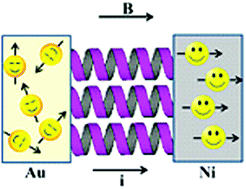Bacteriorhodopsin based non-magnetic spin filters for biomolecular spintronics†
Abstract
We discuss spin injection and spin valves, which are based on organic and biomolecules, that offer the possibility to overcome some of the limitations of solid-state devices, which are based on ferromagnetic metal electrodes. In particular, we discuss spin filtering through bacteriorhodopsin in a solid state biomolecular spin valve that is based on the chirality induced spin selectivity (CISS) effect and shows a magnetoresistance of ∼2% at room temperature. The device is fabricated using a layer of bacteriorhodopsin (treated with n-octyl-thioglucoside detergent: OTG-bR) that is adsorbed on a cysteamine functionalized gold electrode and capped with a magnesium oxide layer as a tunneling barrier, upon which a Ni top electrode film is placed and used as a spin analyzer. The bR based spin valves show an antisymmetric magnetoresistance response when a magnetic field is applied along the direction of the current flow, whereas they display a positive symmetric magnetoresistance curve when a magnetic field is applied perpendicular to the current direction.



 Please wait while we load your content...
Please wait while we load your content...